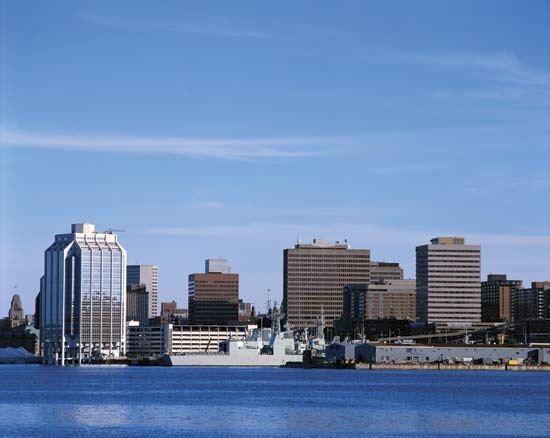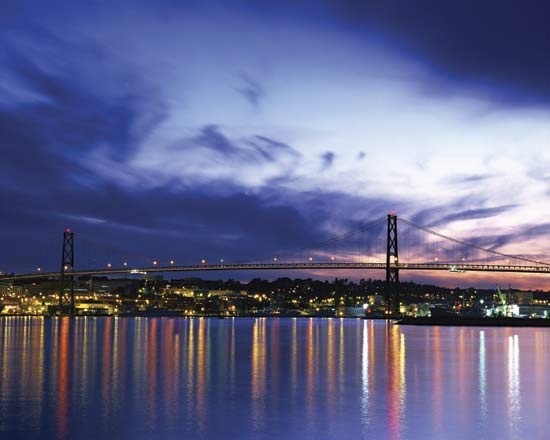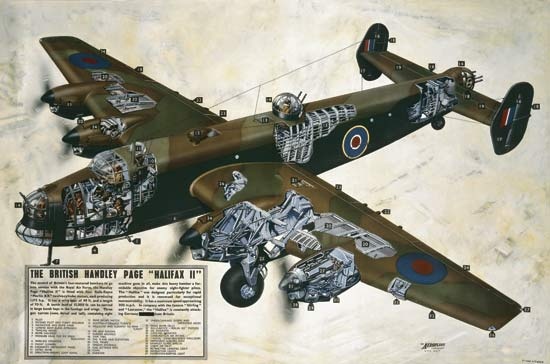Halifax
England, United Kingdom
town, metropolitan borough of Calderdale, metropolitan county of West Yorkshire, historic county of Yorkshire, northern England. An old market town for grain, wool, and cloth trades, it lost its preeminence to Bradford in the 19th century.
Halifax lies in a hilly district on the Hebble, a tributary of the River Calder that flows just to the south. Beacon Hill rises sharply to an elevation of 850 feet (260 metres) and overlooks the town. Road and railway bridges span the valley. Extensive suburban development took place after World War II on the northern side of the town.
In Anglo-Saxon times Halifax formed part of the extensive manor of Wakefield held by King Edward the Confessor. After the Norman Conquest the manor of Halifax (Feslei in Domesday Book) was granted to William, earl of Warenne and Surrey, who made a gift of Yorkshire churches, including Halifax, to the Cluniac priory at Lewes in Sussex. The church was dedicated to St. John the Baptist, patron saint of wool weavers. The cloth trade has been plied in Halifax from an early date—the first record of a weaver there was in 1275. In the account books for 1473–75, Halifax parish had the largest cloth production in the West Riding (a division of the historic county of Yorkshire), a position it retained for three centuries.
Built largely in the 19th century, modern Halifax is a development of the industrial era, though some older buildings remain. The parish church is in the Perpendicular Gothic style, and two earlier churches are traceable—the first of Norman origin and the second of the Early English period. Features of the church are the western tower completed in 1482, unique commonwealth windows of plain glass with beautifully designed leading, and some fine woodwork. Among the public buildings are the town hall, designed by Sir Charles Barry in the Palladian style and opened in 1863; and the central library and Bankfield museum, both of which are housed in Victorian mansions.
Halifax, an industrial town, is traditionally a centre of the woolen and worsted industries, but textile manufacture declined during the 20th century. The manufacture of carpets is important, and other industries include brewing and confectionery. Halifax also specializes in the production of machine tools. Pop. (2001) 83,570.
North Carolina, United States
town, seat of Halifax county, northeastern North Carolina, U.S., on the Roanoke River about 70 miles (113 km) northeast of Raleigh. Settled about 1723, it was made a colonial borough in 1760, named for George Montagu Dunk, 2nd earl of Halifax (Halifax, George Montagu Dunk, 2nd earl of). It thrived as a river port, and between 1776 and about 1782 it was an important political and social centre and a site of the provincial congress. It was there that the Halifax Resolves, the first formal sanction of American independence, were adopted on April 12, 1776. Political activity declined after 1783, when the state assembly moved to Hillsboro (now Hillsborough). Constitution House, where tradition holds that the state constitution was drafted, and other colonial-era and 19th-century structures have been restored. The town was designated a state historic site in 1965 and has become a popular tourist attraction. Pop. (1990) 327; (2000) 344.
Nova Scotia, Canada
 city, capital of Nova Scotia, Canada, and seat (1759) of Halifax county. It lies on Halifax Harbour, an inlet of the Atlantic Ocean, in the central part of the outer (south) shore of the province. The city occupies a rocky peninsula, 4.5 miles (7.2 km) long and 2 miles (3.2 km) wide, that protrudes into the inlet and divides the harbour into an inner (Bedford) and outer basin.
city, capital of Nova Scotia, Canada, and seat (1759) of Halifax county. It lies on Halifax Harbour, an inlet of the Atlantic Ocean, in the central part of the outer (south) shore of the province. The city occupies a rocky peninsula, 4.5 miles (7.2 km) long and 2 miles (3.2 km) wide, that protrudes into the inlet and divides the harbour into an inner (Bedford) and outer basin.First visited by Samuel de Champlain about 1605, the site was occupied in the early 18th century by a French fishing station. Permanent British settlement did not begin until 1749, when Edward Cornwallis founded and fortified the town as a counterbalance to Louisbourg, the French stronghold in Cape Breton, naming it after the 2nd Earl of Halifax (George Montagu Dunk), president of the Board of Trade and Plantations. Halifax continually served as a British army and navy base, one of the most heavily fortified outside Europe, until its dockyard and defenses were taken over by the Canadian government in 1906. Although never besieged, the city suffered from a disastrous munitions ship explosion in 1917 that killed nearly 2,000 people and devastated much of the city's north side. During World Wars I and II, Halifax was Canada's largest and most important naval base.
 The city is Nova Scotia's leading commercial and industrial centre. Its ice-free harbour, one of the busiest in Canada, exports fish, lumber, and agricultural products. Halifax is an Atlantic terminus of two major railways; it is linked to other parts of the province by freeway and to Dartmouth, on the opposite side of the harbour, by ferry and the Angus L. Macdonald and A. Murray MacKay suspension bridges. An international airport is 20 miles (32 km) northeast of the city. Industries include foundries, oil refining, shipbuilding, fish processing, and the manufacture of automobiles, food products, rope and twine, paint and varnish, clothing, and furniture.
The city is Nova Scotia's leading commercial and industrial centre. Its ice-free harbour, one of the busiest in Canada, exports fish, lumber, and agricultural products. Halifax is an Atlantic terminus of two major railways; it is linked to other parts of the province by freeway and to Dartmouth, on the opposite side of the harbour, by ferry and the Angus L. Macdonald and A. Murray MacKay suspension bridges. An international airport is 20 miles (32 km) northeast of the city. Industries include foundries, oil refining, shipbuilding, fish processing, and the manufacture of automobiles, food products, rope and twine, paint and varnish, clothing, and furniture. As the largest city in the Maritime Provinces, Halifax is also an important cultural centre. Its educational institutions include Dalhousie University (founded 1818); University of King's College (Anglican, 1789); St. Mary's University (Roman Catholic, 1841); Mount St. Vincent University for women (Roman Catholic, 1925); and Technical University of Nova Scotia (1907). Its Nova Scotia Museum has historical, geographic, and marine exhibits. Historic buildings include St. Paul's Church (built 1750), the oldest Protestant church in Canada; the Old Dutch Church (1756), Canada's first Lutheran church; Government House (1800–05), official residence of the lieutenant governor; Province House (completed 1818), Canada's oldest parliament building and a notable example of Georgian architecture; Memorial Tower, commemorating the first Canadian elective assembly, in 1758; and Historic Properties, a restoration of 19th-century waterfront buildings. The city's military past is reflected in the Citadel (a hilltop fortress, built 1828–50 on the site of earlier fortifications and now within a national historic park) and Martello Tower and the York Redoubt (restored 18th-century fortifications guarding the sea approaches). Inc. 1842. Pop. (2006) 372,679.
As the largest city in the Maritime Provinces, Halifax is also an important cultural centre. Its educational institutions include Dalhousie University (founded 1818); University of King's College (Anglican, 1789); St. Mary's University (Roman Catholic, 1841); Mount St. Vincent University for women (Roman Catholic, 1925); and Technical University of Nova Scotia (1907). Its Nova Scotia Museum has historical, geographic, and marine exhibits. Historic buildings include St. Paul's Church (built 1750), the oldest Protestant church in Canada; the Old Dutch Church (1756), Canada's first Lutheran church; Government House (1800–05), official residence of the lieutenant governor; Province House (completed 1818), Canada's oldest parliament building and a notable example of Georgian architecture; Memorial Tower, commemorating the first Canadian elective assembly, in 1758; and Historic Properties, a restoration of 19th-century waterfront buildings. The city's military past is reflected in the Citadel (a hilltop fortress, built 1828–50 on the site of earlier fortifications and now within a national historic park) and Martello Tower and the York Redoubt (restored 18th-century fortifications guarding the sea approaches). Inc. 1842. Pop. (2006) 372,679.aircraft
also called Handley Page Halifax
 British heavy bomber used during World War II. The Halifax was designed by Handley Page, Ltd., in response to a 1936 Royal Air Force (RAF) requirement for a bomber powered by two 24-cylinder Rolls-Royce Vulture engines. However, the Vulture encountered problems in development, and the bomber design was reworked in 1937 to take four Rolls-Royce Merlins. The result was a four-engined heavy bomber of mid-wing design with a twin tail that first flew in October 1939, entered production the following year, and began active service with Bomber Command in March 1941.
British heavy bomber used during World War II. The Halifax was designed by Handley Page, Ltd., in response to a 1936 Royal Air Force (RAF) requirement for a bomber powered by two 24-cylinder Rolls-Royce Vulture engines. However, the Vulture encountered problems in development, and the bomber design was reworked in 1937 to take four Rolls-Royce Merlins. The result was a four-engined heavy bomber of mid-wing design with a twin tail that first flew in October 1939, entered production the following year, and began active service with Bomber Command in March 1941.Powered by the 1,640-horsepower Merlins, the Halifax had a wingspan of 104 feet (31.7 metres) and was 72 feet (22 metres) long. It had a maximum speed of 280 miles (450 km) per hour and a ceiling of 24,000 feet (7,300 metres), though the latter was substantially lower when carrying a full combat load. With a bomb load of 5,800 pounds (2,600 kg), the Halifax had a range of 1,860 miles (3,000 km), and it could carry its full bomb load of 13,000 pounds (5,900 kg) to ranges of 1,000 miles (1,600 km). Shortages of Merlin engines led to the production of several hundred Halifaxes powered by more-powerful Bristol Hercules air-cooled radial engines. These entered service in early 1944 and were an improvement over Merlin-engined Halifaxes, but they were still markedly inferior to the RAF's principal four-engined bomber, the Lancaster.
Early versions of the Halifax were armed with a power-operated tail turret mounting four 0.303-inch (7.7-mm) machine guns, powered turrets mounting two 0.303s on the upper fuselage and belly, and two 0.303s in the nose blister. Later versions removed the belly turret (mounting an H2S radar bombing system in its place), replaced the twin-gun upper turret with one mounting four 0.303s, and carried only a single machine gun on a flexible mount in the nose. In common with those of other RAF bombers, the Halifax's 0.303-inch machine guns were badly outranged by cannon-armed German fighters—an area in which U.S. bombers were much better-served by their heavy 0.50-inch (12.7-mm) machine guns.
The Halifax was used primarily in night bombing attacks on German cities. However, it was less successful in that role than the Lancaster, and significant numbers of Halifaxes were used for maritime reconnaissance, as glider tugs, as paratroop transports (particularly in drops of arms and agents to Resistance fighters in German-occupied Europe), and as transports for personnel and high-priority cargo. More than 6,000 Halifaxes were built before production ceased in 1946.
- Queensland
- Queensland, flag of
- Queenston Heights, Battle of
- Queenstown
- Queen's University at Kingston
- Queens, Valley of the
- Queiroz Law
- Queiroz, Rachel de
- quelea
- Queler, Eve
- Quelimane
- Quemoy Island
- quenching
- Queneau, Raymond
- Quennell, Sir Peter
- Quenstedt, Friedrich August
- Quental, Antero Tarquínio de
- Quentin Massys
- Querandí
- quercitron bark
- Quercy
- Queremistas
- Querido, Israël
- quern
- Quervain, Marcel Roland de